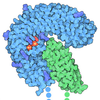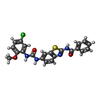Entry Database : PDB / ID : 6pmcTitle TRK-A IN COMPLEX WITH LIGAND 1a High affinity nerve growth factor receptor Keywords / Function / homology Function Domain/homology Component
/ / / / / / / / / / / / / / / / / / / / / / / / / / / / / / / / / / / / / / / / / / / / / / / / / / / / / / / / / / / / / / / / / / / / / / / / / / / / / / / / / / / / / / / / / / / / / / / / / / / / / / / / / / / / / / / / / / / / / / / / / / / / / / / / / / Biological species Homo sapiens (human)Method / / / Resolution : 2.19 Å Authors Subramanian, G. / Brown, D.G. Journal : Rsc Med Chem / Year : 2020Title : Synthetic inhibitor leads of human tropomyosin receptor kinase A ( h TrkA).Authors : Subramanian, G. / Vairagoundar, R. / Bowen, S.J. / Roush, N. / Zachary, T. / Javens, C. / Williams, T. / Janssen, A. / Gonzales, A. History Deposition Jul 1, 2019 Deposition site / Processing site Revision 1.0 Feb 26, 2020 Provider / Type Revision 1.1 Feb 3, 2021 Group / Category / citation_authorItem _citation.country / _citation.journal_abbrev ... _citation.country / _citation.journal_abbrev / _citation.journal_id_ISSN / _citation.journal_volume / _citation.page_first / _citation.page_last / _citation.pdbx_database_id_PubMed / _citation.title / _citation_author.name Revision 1.2 Oct 30, 2024 Group Advisory / Data collection ... Advisory / Data collection / Database references / Structure summary Category chem_comp_atom / chem_comp_bond ... chem_comp_atom / chem_comp_bond / database_2 / pdbx_entry_details / pdbx_modification_feature / pdbx_unobs_or_zero_occ_atoms Item / _database_2.pdbx_database_accession / _pdbx_entry_details.has_protein_modification
Show all Show less
 Open data
Open data Basic information
Basic information Components
Components Keywords
Keywords Function and homology information
Function and homology information Homo sapiens (human)
Homo sapiens (human) X-RAY DIFFRACTION /
X-RAY DIFFRACTION /  SYNCHROTRON /
SYNCHROTRON /  FOURIER SYNTHESIS / Resolution: 2.19 Å
FOURIER SYNTHESIS / Resolution: 2.19 Å  Authors
Authors Citation
Citation Journal: Rsc Med Chem / Year: 2020
Journal: Rsc Med Chem / Year: 2020 Structure visualization
Structure visualization Molmil
Molmil Jmol/JSmol
Jmol/JSmol Downloads & links
Downloads & links Download
Download 6pmc.cif.gz
6pmc.cif.gz PDBx/mmCIF format
PDBx/mmCIF format pdb6pmc.ent.gz
pdb6pmc.ent.gz PDB format
PDB format 6pmc.json.gz
6pmc.json.gz PDBx/mmJSON format
PDBx/mmJSON format Other downloads
Other downloads 6pmc_validation.pdf.gz
6pmc_validation.pdf.gz wwPDB validaton report
wwPDB validaton report 6pmc_full_validation.pdf.gz
6pmc_full_validation.pdf.gz 6pmc_validation.xml.gz
6pmc_validation.xml.gz 6pmc_validation.cif.gz
6pmc_validation.cif.gz https://data.pdbj.org/pub/pdb/validation_reports/pm/6pmc
https://data.pdbj.org/pub/pdb/validation_reports/pm/6pmc ftp://data.pdbj.org/pub/pdb/validation_reports/pm/6pmc
ftp://data.pdbj.org/pub/pdb/validation_reports/pm/6pmc Links
Links Assembly
Assembly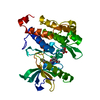
 Components
Components Homo sapiens (human) / Gene: NTRK1, MTC, TRK, TRKA / Production host:
Homo sapiens (human) / Gene: NTRK1, MTC, TRK, TRKA / Production host: 
 X-RAY DIFFRACTION / Number of used crystals: 1
X-RAY DIFFRACTION / Number of used crystals: 1  Sample preparation
Sample preparation SYNCHROTRON / Site:
SYNCHROTRON / Site:  Diamond
Diamond  / Beamline: I02 / Wavelength: 0.9282 Å
/ Beamline: I02 / Wavelength: 0.9282 Å Processing
Processing FOURIER SYNTHESIS / Resolution: 2.19→45.64 Å / Cor.coef. Fo:Fc: 0.94 / Cor.coef. Fo:Fc free: 0.92 / Cross valid method: THROUGHOUT / σ(F): 0 / ESU R: 0.304 / ESU R Free: 0.251
FOURIER SYNTHESIS / Resolution: 2.19→45.64 Å / Cor.coef. Fo:Fc: 0.94 / Cor.coef. Fo:Fc free: 0.92 / Cross valid method: THROUGHOUT / σ(F): 0 / ESU R: 0.304 / ESU R Free: 0.251  Movie
Movie Controller
Controller







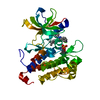

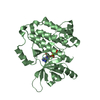


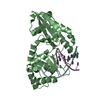
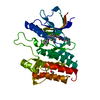

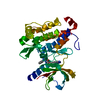




 PDBj
PDBj




